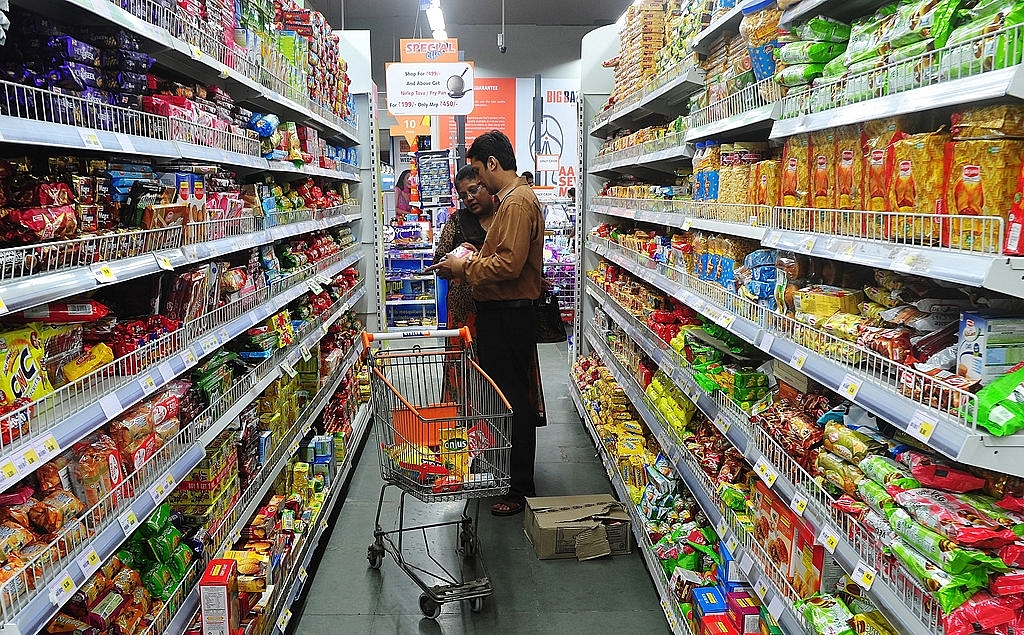Business
FMCG Companies Begin Passing on Commodity Benefits to Consumers As Rural Demand Finally Turns Positive

FMCG companies have cut prices of various products to pass on the benefits of GST rate reduction.(INDRANIL MUKHERJEE/AFP/GettyImages)
After a dismal performance in the financial year 2022 (FY22) and FY23, fast-moving consumer goods (FMCG) companies could be looking at a turnaround.
Over the last two years, demand saw a sharp slowdown in some areas while commodity costs went up sharply, squeezing the profits of FMCG companies.
Why Did Consumers Shift Away from Consumption?
Even though the companies saw some revenue growth, most of it was driven by price increases instead of volume increases.
Companies were raising the prices of larger packs to pass on costs to customers, while smaller packs saw a cut in weight (grammage).
Increasing the lower pack’s price points would result in lower demand; hence, lower-priced packs see a cut in grammage.
Some low-priced packs, like the Rupee Five biscuit pack, were even removed from the market since it would lead to wafer-thin or negative margins for companies.
As a result of the price hike and the after-effects of the pandemic, a significant portion of consumption among the less-privileged either stopped entirely or shifted towards the unorganised/unbranded segments. As a result, almost all FMCG companies, especially those concerned with food, saw negative or extremely low single-digit growth in margins.
For instance, Britannia Industries saw marginal volume growth despite a 15 per cent revenue growth. Other players like Marico, who cater partly to price-conscious customers, also saw low-volume growth. Even some players like Hindustan Unilever, which has exposure to relatively more premium brands and non-food categories, saw a slower volume than it had seen in the past.
The decline in FMCG consumption sharply contrasted with the rapid rise in consumption of luxury items, cars, among other premium items over the same period. Even the decline in the sale of country liquor versus the increases in sales of premium liquor categories suggested a similar trend in consumption, which some called the K-shaped recovery.
Rural Markets are Showing Green Shoots
Currently, FMCG companies are cutting back on price increases while giving back grammage to consumers. Both checks with distributors and management commentary of listed FMCG companies indicate that companies are now working on increasing grammage while reducing prices as commodity prices fall. At the same time, rural demand is expected to pick up. According to market research firms, rural demand has turned positive after a series of quarters of decline in volume growth. According to Bizom, the rural FMCG market grew by 12 per cent, compared to 5 per cent in February. Overall, the fourth quarter of FY23 saw a growth of 0.3 per cent, while urban grew at 5.3 per cent, according to NielsenIQ.
Prices Are Headed Lower, and Volumes Higher
From the point of FMCG companies, dropping prices would help them grow volumes. However, it is quite clearly visible that price declines have lacked commodity price declines across the globe, and India is no different.
A slow pace of price decline and grammage increases will help FMCG majors bring up their margins to normal levels.
As consumers recover, demand will likely shift back from unbranded products to branded products and from unorganised players to organised players. Even consumers, who had been forced out of the market due to price increases, would find goods becoming affordable again.
The rural market is predominantly composed of consumers with lower purchasing power. This is evidenced by the fact that despite contributing to around 65 per cent of the country’s population, rural consumer goods consumption makes up just over 35 per cent of total consumption. Hence, lower prices would help spur rural demand.
Higher margins and volume-driven growth could help please FMCG sector investors who have had several reasons to be jittery over the last two years.
While the monsoon would strongly impact rural demand, the current scenario looks positive.
Introducing ElectionsHQ + 50 Ground Reports Project
The 2024 elections might seem easy to guess, but there are some important questions that shouldn't be missed.
Do freebies still sway voters? Do people prioritise infrastructure when voting? How will Punjab vote?
The answers to these questions provide great insights into where we, as a country, are headed in the years to come.
Swarajya is starting a project with an aim to do 50 solid ground stories and a smart commentary service on WhatsApp, a one-of-a-kind. We'd love your support during this election season.
Click below to contribute.
Latest